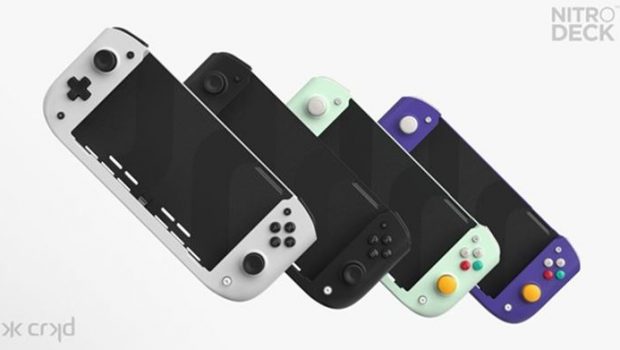CRKD Nitro Deck for Nintendo Switch Review @crkdgg
Summary: A high-quality third-party accessory for Nintendo Switch that is durable, ergonomic and customizable.
4.5
Seven years on, the Nintendo Switch reigns supreme in the handheld console market. It’s got the games, the looks, and the play anywhere appeal. But when playing on-the-go, I can’t help but dislike the size and feel of the Joy-Con controls. Discomfort is the curse of the big hands gamer.
Enter CRKD’s Nitro Deck, a third-party controller accessory that encases the Switch into a sturdy shell with bigger buttons, programmable back paddles and hall effect joy-sticks.
With a focus on ergonomics and neat extras, the Nitro Deck presents a lot of appeal for Switch gamers seeking comfort and customization in their handheld gaming. So, is it worth the price?
First thing’s first: the Nitro Deck is a two tier product with a base edition priced at $99 AUD available in White and Black colour models, and a limited edition priced at $149 AUD available in Retro Mint and Retro Purple, the latter being a inspired throwback to Gamecube era colours.
The limited edition also comes with a decent quality black carry case, 5m USB-C to A cable, and spare set of thumbstick toppers that can be swapped in neatly (depending on your preference). Most importantly, the Nitro Deck is compatible with both the standard and OLED Switch models.

As a 90’s kid with Y2K nostalgia, the Retro Purple is a clear frontrunner and up-close, the indigo purple colour scheme, matte finish and two-tone face buttons and control sticks pop out nicely. Attaching the Switch is also easy, with tabs and a USB-C port that click upon connection.
It’s all held in place quite securely, but I found detaching the Switch (using the release latch at the back) to be harder and less sleek than it should be, as you have to grab the screen itself to slide it off.

So, how does it work?
Instead of a bluetooth connection, the Nitro Deck works by toggling the Pro Controller Wired Communication system setting. This allows the Switch to detect the Nitro Deck as a Pro Controller. Because the Nitro Deck cradles the Switch via its USB-C port, the Deck does away with wireless interference concerns and touts low-latency gaming, which I found to be true. It has a USB-C input on its back to charge your battery, and output to connect the Nitro Deck as a wired controller when your Switch is docked. Importantly, I found the Nitro Deck did not seem to drain the Switch battery faster than normal usage without it.
In terms of build quality, the Nitro Deck is decently hefty and feels tailored for large hands. For me, it made the Switch feel much nicer to hold during extended handheld play sessions. The kickstand at the back is also sturdy and supportive, making it easy to test and play Cuphead and Smash Bros at the dinner table (yeah, I know). All in all, it’s not the type of controller option for those off-put by heavier casing or a ‘thicc’ aesthetic, as it does add a noticeable weight to the handheld gaming experience. But for big handed buffoons like me, it’s comfy and awesome.

It’s the feel of the noticeably larger analog sticks, face buttons and bumpers that ultimately won me over, though your own preference may vary depending on the gaming controllers you grew up with. I absolutely dig the grip of the Nitro Deck’s joysticks, which come with replacement toppers and utilise hall effect tech to negate stick drift and minimise wear-and tear, and are a great option for Switch owners who have had to endure faulty Joy-Cons over the years. It’s not a totally transformative replacement, but certainly a premium and very comfortable new option.
The face and shoulder buttons, meanwhile, are clicker and crisper to press than the Joy-Cons’. The triggers and traditional D-Pad look smooth in appearance, but aren’t as satisfying to press. The back set of four programmable paddles are a neat addition for certain games where shortcut inputs are handy to have, and they align nicely with where the ring fingers naturally rest (they can also be disabled using the included program button at the back of the Nitro Deck). If you fancy, there’s a turbo mode function you can set on a specific button for further tinkering.

Now, onto a few minor compromises.
The Nitro Deck entirely lacks an NFC touchpoint, which may or may not be a dealbreaker depending on if you are an Amiibo collector who uses them regularly to unlock DLC and bonus goodies in your Switch games. HD rumble is also out, but standard rumble and motion controls are in. However, rumble with the Nitro Deck is noticeably louder than with just the Joy-Cons, so much so that I had to test both options back-and-forth while jumping around in Mario Odyssey to confirm I wasn’t going bonkers. Is it a deal breaker? No, but it’s something to be aware of if you’re sensitive to sound and vibration.

The Final Verdict
The Nitro Deck is a sleek and colourful third-party controller option for certain Switch gamers seeking an ergonomic and customized alternative to the default Joy-Cons when playing in handheld or tabletop modes. The $99 AUD price-tag isn’t too bad, while the $149 price for the cooler Limited Edition colours is perhaps a steep bump if you aren’t in need of another carry case and joystick stoppers. Overall, if you’re a Switch gamer who does a lot of handheld gaming, it’s a solid option.







